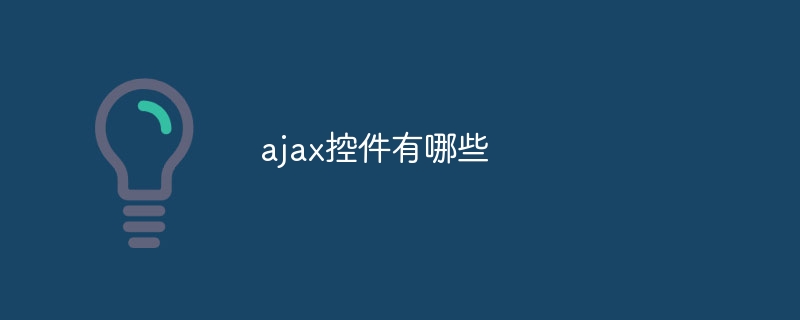Home >Web Front-end >Front-end Q&A >What are the ajax controls?
What are the ajax controls?
- 百草Original
- 2023-11-17 14:46:061545browse
Ajax controls include jQuery, Axios, Fetch API, XMLHttpRequest, jQuery AJAX Forms, jQuery UI Autocomplete, jQuery UI Datepicker and jQuery UI Slider, etc. Detailed introduction: 1. jQuery is a popular JavaScript library that provides many functions and simplified APIs, including AJAX request processing and more.

The operating system for this tutorial: Windows 10 system, DELL G3 computer.
AJAX (Asynchronous JavaScript and XML) is a web development technology that uses multiple technologies. It allows web pages to exchange data with the server and update part of the web page content without reloading the entire page. In web development, using AJAX technology can create a smoother and faster user experience. When implementing AJAX, you usually need to use some controls or libraries to simplify the development process. The following are some common AJAX controls:
1. jQuery
jQuery is a popular JavaScript library that provides many functions and simplified APIs, including the handling of AJAX requests. jQuery's AJAX function can be implemented by using .ajax(), .get(), $.post() and other functions. These functions can be used to send GET and POST requests and process response data. jQuery also provides several other tools and plugins to further simplify the AJAX development process.
2. Axios
Axios is a Promise-based HTTP client for browsers and Node.js. It provides a simple yet powerful API for sending HTTP requests, including GET, POST, PUT, DELETE, etc. Axios has the ability to intercept requests and responses, making it easy to handle errors and exceptions. Axios also supports canceling requests, setting request headers, handling HTTP responses, and more.
3. Fetch API
Fetch API is a native API of modern browsers and is used to send HTTP requests. It returns a Promise object, allowing you to use .then() or async/await syntax to handle response data. Compared to Axios, the Fetch API is more lightweight, but may require more configuration to handle complex requests. The Fetch API provides a global fetch() function, which can be used to send GET, POST and other requests.
4. XMLHttpRequest
XMLHttpRequest is an early AJAX technology that allows the browser to exchange data with the server through JavaScript. The XMLHttpRequest object provides an open() method to set the request type, URL, asynchronous and other parameters, and a send() method to send the request. When the response returns, you can process the response data by setting a callback function. Although XMLHttpRequest has been around for a long time, it has now been gradually replaced by more modern technologies such as Fetch API and Axios.
5. jQuery AJAX Forms
jQuery AJAX Forms is a jQuery plug-in that provides the function of submitting form data without refreshing the page. This plug-in can send GET or POST requests through the $.ajax() method, and send the form data to the server as the request body. Response data can be used to update content on the page or perform other actions.
6. jQuery UI Autocomplete
jQuery UI Autocomplete is a jQuery plug-in that can provide automatic completion suggestions based on user input. This plugin implements autocomplete functionality by receiving data returned from the server and displaying a list of suggestions. Users can select a suggestion to populate form fields or perform other actions.
7. jQuery UI Datepicker
jQuery UI Datepicker is a jQuery plug-in that provides a date picker component. This plug-in can implement the date selection function by receiving the date data returned by the server and displaying it on a date picker control. Users can select a date and perform other actions.
8. jQuery UI Slider
jQuery UI Slider is a jQuery plug-in that provides a slider component. This plug-in can implement the slider control function by receiving the numerical data returned by the server and displaying it on a slider control. Users can use the slider to select a value and perform other operations.
In addition to the common AJAX controls mentioned above, there are some other controls or libraries that can be used to handle specific operations or behaviors, such as form validation, rich text editors, etc. These controls or libraries can be used in conjunction with AJAX technology to achieve richer and more dynamic page interaction effects. It should be noted that different controls or libraries may have different advantages, disadvantages, and applicable scenarios, so they need to be selected and used according to specific circumstances in specific implementations.
The above is the detailed content of What are the ajax controls?. For more information, please follow other related articles on the PHP Chinese website!

